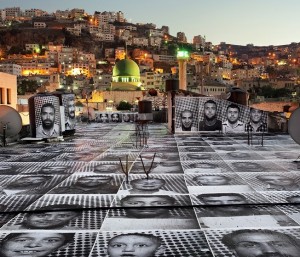Tribeca Talks — Catching Up with JR & the Inside Out Project in NY’s Times Square
It’s been a whirlwind few years for French artist, JR . In 2011 he received the prestigious TED Prize and a million dollars to change the world. JR’s wish: to connect people through a global art project he calls Inside Out, which inspires citizens of the world to take close-up portraits of themselves and upload them to the project’s Web site. JR’s team, located in Paris and New York, prints the images on 36” x 53” paper and sends them back with instructions on how to post them on walls, fences, bridges throughout their cities, neighborhoods and villages.
The project is free to anyone who wishes to participate as long as the photo is a portrait; there’s no promotion of brands, logos or organizations; and there’s no messages of hate. Thus far, over 135,000 people have uploaded portraits to the Web site, spanning 10,000 locations in over 90 countries.
Inside Out: The People’s Art Project, directed by Alastair Siddons, follows JR’s dream as it comes to life across the globe — from the West Bank to Haiti to Tunisia to Standing Rock Indian Reservation in North Dakota — and the world glows with vibrant portraits of humanity. Last month, the film premiered at the Tribeca Film Festival, and JR and his team have been traveling New York’s five boroughs with their photo booth truck, capturing the diversity of the city of lights. On April 22, they kicked off a larger than life New York experience for city dwellers and tourists alike in Times Square, where, until May 10, the public is invited to participate in the largest global art project ever. The film will air on HBO on May 20 at 9 p.m. ET/PT.
GALO had the chance to speak with JR at the center of Times Square amidst hundreds of participants and onlookers. As posters are pasted to the street, JR offers his thoughts on what the project means to him.
GALO: Thank you for taking time out of the busiest square in New York to talk for a few minutes. You’ve been driving your photo truck around New York for over a week and now you are at the heart of Manhattan. With a city of 8.5 million residents, do you have a target number of portraits you’d like to add from New York City?
JR: No. I have no number in mind. The beauty of this project is that it’s really about the people. The people are the ones that decide where and how Inside Out happens. Times Square asked me to do it. If they ask, I come. I want to give it to the people. And it’s free for anyone who wants to participate. All this synergy is contagious.
GALO: What’s the public response been?
JR: A lot of followers from my Twitter account have come down here. But there are also lots of tourists from other countries who didn’t know what the project was and then wanted to connect with things — to be a part of it. It’s great. I love that aspect of Inside Out.
GALO: It’s been two years since you received the coveted TED Prize, which required you to make a wish to change the world. In your acceptance speech, you laid out your challenge: “My wish to you is to stand up for what you care about by participating in a global art project. Tell me what you stand for and together we can turn the world inside out.” At the time, did you see “inside out” as a state of mind? A state of existence? A state resistance?
JR: Inside Out is a platform that can cover all of this — resistance, politics, art, change — depending on the context where people live. I still want to leave it open for all people. For me, it’s a learning process. And if you don’t just let it happen, you’ll never know what the possibilities will be.
GALO: Has your definition changed since you first conceived it?
JR: No, when I made it, I made it to be pretty open. The people understood that it was a giant project. I have no control over it. It all depends on whether people want to make Inside Out stop or continue. And so far, they want it to continue.
GALO: There is a touching moment in the film when you ask Benoit, the Haitian teen who has taken all the photographs, if he is proud of his work. He smiles and tells you, “Photography gave me my life back.” Most of the regions featured in the film are impoverished, war torn or environmentally challenged locations. Was Benoit’s transformation one of your wishes — to bring art to those needing an avenue to express themselves?
JR: I’ve been in a lot of countries in the last 13 years. I knew Inside Out might make an impact in their lives, cities and communities. All I wanted was that they take ownership of it. And they have.
“Inside Out: The People’s Art Project” opened on April 20 at the Tribeca Film Festival in New York City. The film will air on HBO on May 20 at 9 p.m. ET/PT.
Featured image: “INSIDE OUT,” Nablus, Palestine, 2011. Photo Credit: JR.


